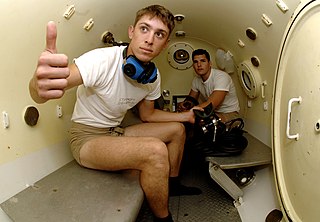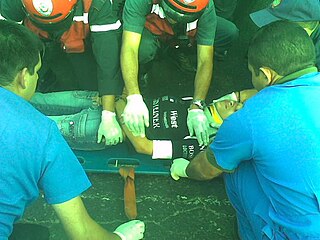Related Research Articles

Medicine is the science and practice of caring for a patient, managing the diagnosis, prognosis, prevention, treatment, palliation of their injury or disease, and promoting their health. Medicine encompasses a variety of health care practices evolved to maintain and restore health by the prevention and treatment of illness. Contemporary medicine applies biomedical sciences, biomedical research, genetics, and medical technology to diagnose, treat, and prevent injury and disease, typically through pharmaceuticals or surgery, but also through therapies as diverse as psychotherapy, external splints and traction, medical devices, biologics, and ionizing radiation, amongst others.
Factitious disorder imposed on self, also known as Munchausen syndrome, is a factitious disorder in which those affected feign or induce disease, illness, injury, abuse, or psychological trauma to draw attention, sympathy, or reassurance to themselves. Munchausen syndrome fits within the subclass of factitious disorder with predominantly physical signs and symptoms, but patients also have a history of recurrent hospitalization, travelling, and dramatic, extremely improbable tales of their past experiences. The term Munchausen syndrome derives its name from the fictional character Baron Munchausen.

Anaphylaxis is a serious, potentially fatal allergic reaction and medical emergency that is rapid in onset and requires immediate medical attention regardless of use of emergency medication on site. It typically causes more than one of the following: an itchy rash, throat closing due to swelling that can obstruct or stop breathing; severe tongue swelling that can also interfere with or stop breathing; shortness of breath, vomiting, lightheadedness, loss of consciousness, low blood pressure, and medical shock. These symptoms typically start in minutes to hours and then increase very rapidly to life-threatening levels. Urgent medical treatment is required to prevent serious harm and death, even if the patient has used an epipen or has taken other medications in response, and even if symptoms appear to be improving.
In psychology, alogia is poor thinking inferred from speech and language usage. There may be a general lack of additional, unprompted content seen in normal speech, so replies to questions may be brief and concrete, with less spontaneous speech. This is termed poverty of speech or laconic speech. The amount of speech may be normal but conveys little information because it is vague, empty, stereotyped, overconcrete, overabstract, or repetitive. This is termed poverty of content or poverty of content of speech. Under Scale for the Assessment of Negative Symptoms used in clinical research, thought blocking is considered a part of alogia, and so is increased latency in response.

Chest pain is pain or discomfort in the chest, typically the front of the chest. It may be described as sharp, dull, pressure, heaviness or squeezing. Associated symptoms may include pain in the shoulder, arm, upper abdomen, or jaw, along with nausea, sweating, or shortness of breath. It can be divided into heart-related and non-heart-related pain. Pain due to insufficient blood flow to the heart is also called angina pectoris. Those with diabetes or the elderly may have less clear symptoms.

Signs and symptoms are the observed or detectable signs, and experienced symptoms of an illness, injury, or condition.
A factitious disorder is a mental disorder in which a person, without a malingering motive, acts as if they have an illness by deliberately producing, feigning, or exaggerating symptoms, purely to attain a patient's role. People with a factitious disorder may produce symptoms by contaminating urine samples, taking hallucinogens, injecting fecal material to produce abscesses, and similar behaviour. The word factitious derives from the Latin word factītius, meaning "human-made".
The mental status examination (MSE) is an important part of the clinical assessment process in neurological and psychiatric practice. It is a structured way of observing and describing a patient's psychological functioning at a given point in time, under the domains of appearance, attitude, behavior, mood and affect, speech, thought process, thought content, perception, cognition, insight, and judgment. There are some minor variations in the subdivision of the MSE and the sequence and names of MSE domains.
A psychiatric history is the result of a medical process where a clinician working in the field of mental health systematically records the content of an interview with a patient. This is then combined with the mental status examination to produce a "psychiatric formulation" of the person being examined.

Diving medicine, also called undersea and hyperbaric medicine (UHB), is the diagnosis, treatment and prevention of conditions caused by humans entering the undersea environment. It includes the effects on the body of pressure on gases, the diagnosis and treatment of conditions caused by marine hazards and how relationships of a diver's fitness to dive affect a diver's safety. Diving medical practitioners are also expected to be competent in the examination of divers and potential divers to determine fitness to dive.
The SOAP note is a method of documentation employed by healthcare providers to write out notes in a patient's chart, along with other common formats, such as the admission note. Documenting patient encounters in the medical record is an integral part of practice workflow starting with appointment scheduling, patient check-in and exam, documentation of notes, check-out, rescheduling, and medical billing. Additionally, it serves as a general cognitive framework for physicians to follow as they assess their patients.

Advanced trauma life support (ATLS) is a training program for medical providers in the management of acute trauma cases, developed by the American College of Surgeons. Similar programs exist for immediate care providers such as paramedics. The program has been adopted worldwide in over 60 countries, sometimes under the name of Early Management of Severe Trauma, especially outside North America. Its goal is to teach a simplified and standardized approach to trauma patients. Originally designed for emergency situations where only one doctor and one nurse are present, ATLS is now widely accepted as the standard of care for initial assessment and treatment in trauma centers. The premise of the ATLS program is to treat the greatest threat to life first. It also advocates that the lack of a definitive diagnosis and a detailed history should not slow the application of indicated treatment for life-threatening injury, with the most time-critical interventions performed early.
Nursing assessment is the gathering of information about a patient's physiological, psychological, sociological, and spiritual status by a licensed Registered Nurse. Nursing assessment is the first step in the nursing process. A section of the nursing assessment may be delegated to certified nurses aides. Vitals and EKG's may be delegated to certified nurses aides or nursing techs. It differs from a medical diagnosis. In some instances, the nursing assessment is very broad in scope and in other cases it may focus on one body system or mental health. Nursing assessment is used to identify current and future patient care needs. It incorporates the recognition of normal versus abnormal body physiology. Prompt recognition of pertinent changes along with the skill of critical thinking allows the nurse to identify and prioritize appropriate interventions. An assessment format may already be in place to be used at specific facilities and in specific circumstances.
OPQRST is a mnemonic initialism used by medical professionals to accurately discern reasons for a patient's symptoms and history in the event of an acute illness. It is specifically adapted to elicit symptoms of a possible heart attack. Each letter stands for an important line of questioning for the patient assessment. This is usually taken along with vital signs and the SAMPLE history and would usually be recorded by the person delivering the aid, such as in the "Subjective" portion of a SOAP note, for later reference.
SOCRATES is a mnemonic acronym used by emergency medical services, physicians, nurses, and other health professionals to evaluate the nature of pain that a patient is experiencing.

Medical diagnosis is the process of determining which disease or condition explains a person's symptoms and signs. It is most often referred to as a diagnosis with the medical context being implicit. The information required for a diagnosis is typically collected from a history and physical examination of the person seeking medical care. Often, one or more diagnostic procedures, such as medical tests, are also done during the process. Sometimes the posthumous diagnosis is considered a kind of medical diagnosis.
In a medical encounter, a past medical history is the total sum of a patient's health status prior to the presenting problem.
Rapid trauma assessment is a method most commonly used by emergency medical services to identify hidden and obvious injuries in a trauma victim. The goal is to identify and treat immediate threats to life that may not have been obvious during an initial assessment. After an initial assessment involving basic checks on airway, breathing and circulation, the caregiver considers things like mechanism of injury to determine if a more rapid diagnostic approach is indicated than might otherwise be used. A rapid trauma assessment should take no more than 90 seconds.
AEIOU-TIPS is a mnemonic acronym used by some medical professionals to recall the possible causes for altered mental status. Medical literature discusses its utility in determining differential diagnoses in various special populations presenting with altered mental status including infants, children, adolescents, and the elderly. The mnemonic also frequently appears in textbooks and reference books regarding emergency medicine in a variety of settings, from the emergency department and standard emergency medical services to wilderness medicine.
References
- ↑ Ed Dickinson; Dan Limmer; O'Keefe, Michael F.; Grant, Harvey D.; Bob Murray (2008). Emergency Care (11th ed.). Englewood Cliffs, N.J: Prentice Hall. p. 242. ISBN 978-0-13-500524-8.
- ↑ Marx, J (2010). Rosen's emergency medicine: concepts and clinical practice 7th edition . Philadelphia: Mosby/Elsevier. pp. 267. ISBN 978-0-323-05472-0.